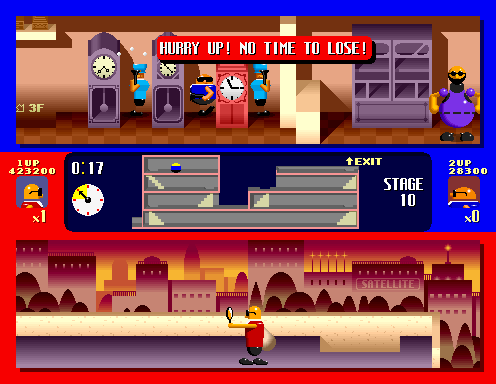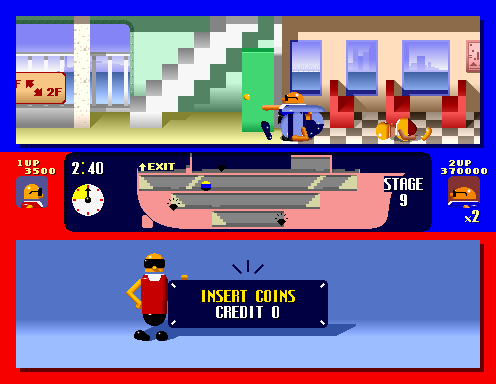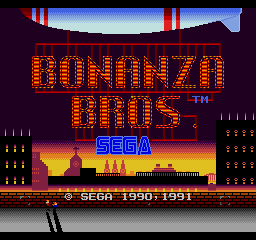EDITOR'S NOTE:
You know what, I'm happy I've got this to deal with, no, truly, it's the highlight of my day- we're dealing with two games that have almost completely different native resolutions! And we're playing them both at the same time! Oh joy, oh joy, and I'm the hapless jackass who has to sort all this image bullshit out! Bloody hellfire. So, the arcade Bonanza Bros. uses a medium-resolution display which outputs from MAME as 496 x 384, translated to English the size of that is bastard massive compared to our normal guff, and much much bigger than Mega Drive shots. So, we thought of a few ways to try and tackle this, and settled upon the obvious one- keep the two versions separate. So we'll talk about the arcade version while showing those screenshots at 80% of their original resolution (they're flippin' huge otherwise, click to make them bigger) then switch to the Mega Drive port with appropriate screenshots. Not the most elegant solution in the world, but problems arise if we try to change the size of things to keep them exactly the same- shrink the arcade screenshots and you can't see anything that's going on, blow up the Mega Drive screenshots and they don't look great and they're still not exactly the same size anyway...
Additionally, what you whippersnappers in the United States call the 'first floor' of a building is called the 'ground floor' over here in the UK. However, background signs in the arcade version of this game use the American nomenclature. For the sake of clarity, we'll be using the same term as the game, which means calling the ground floor the first floor. I'm sure this means our passports are now revoked and the Queen's just blocked us on Twitter, but we'll live. Hopefully all of this this isn't too confusing for you. It's too confusing for me but I'll be fine, probably, I'll probably be fine.
I have a soft spot large enough to be seen from space for the Bonanza Bros., and if you know anything about me you can guess why.
A game by Sega? Yep. A comically-themed game at that? Absolutely. One that's obscure but prone to the odd resurface here and there? You know it.
I dig it so much, in fact, that this article's gonna cover two versions of the game!


Initially released in 1990 in arcades for Sega's lesser-known System 24- an interesting system that used a floppy disk to store data and that needed a medium resolution arcade monitor to work, used to neat effect in games like Rough Racer and Crack Down which had very detailed spritework- Bonanza Bros. has you take on the role of either Robo (Player 1, lanky and red) or Mobo (Player 2, stout and blue), the siblings of the title. The motivations for these awful, wonderful boys changes depending on what version of the plot you ascribe to- this is something we'll get back to later, but for now let's go with the original arcade story, that they've been hired to gather 'evidence' to clean up Badville by hitting places like a bank, a department store, and even a gold mine and a trap-laden pyramid. They're not thieves, promise! Their mission is to grab all of the treasures evidence and make it to the exit, where they'll make a daring escape via their personal blimp, within a self-imposed three minute time limit. That's how you know they're the real deal.
However, I think setting the scene, and thus expectations, needs to be done first. Manabu Kusunaki was interviewed for Sega Mega Drive / Genesis Complete Works about his graphic design work on this game, and he mentioned that a lot of home computer games for formats like the Amiga were studied during its development. I have a suspicion this may have been something that teams working on System-24 games were doing across the board. This game, Gain Ground and Crack Down are all arcade games but have varying degrees of home computer game vibes to them with somewhat of a focus on slower gameplay than you'd expect from the creators of Altered Beast and Sega Ninja- Crack Down bears more than a few similarities to Konami's Metal Gear, morphed to be more arcade-like; Gain Ground is a take on the top-down shooter but with a far more methodical, tactical approach required as you assess the single-screen battlefield and use your gathered select of soldiers with their own strengths and weaknesses; and Bonanza Bros.? Well, you can rule out Keystone Kapers as Kusunaki shot that one down, but I wouldn't be surprised if the home computer version of Spy vs. Spy (it got a Famicom release, after all) was some kind of influence- the split-screen presentation and the more comical approach makes me think of Bonanza Bros., even if most of the game mechanics aren't from there. Other games you can look at include Durell Software's Saboteur! and, of course, Metal Gear. The common thread here is a somewhat slower-paced game with a focus on evasion rather than pure combat, which Bonanza Bros. does its best to adapt to an arcade format.


How does it go about doing so? The flyer bills Bonanza Bros. as a "Comical 'Reaction' Game" which is, well, a little vague, but it does clue you in that it's going to be a somewhat different approach (the flyer also has perhaps one of my favourite arcade flyer sentences, "HERE WE GO, YOU GANG OF CLOWNS!!"). Across the game's 12 locations (10 in the Mega Drive port), Robo and Mobo have to steal specific treasures noted on the map of each stage before they're allowed to climb the stairs to the exit. All the while, the boys will have to avoid security forces dotted around each locale who will, upon sighting them, either chase them, club them, shoot them, bite them (there's dogs about, you know) or even lob bombs at them, all of which take a life away. Luckily, the boys have some tricks up their sleeves, notably the ability to move between two 'lanes' in each stage, one in the foreground and another in the background. This doesn't sound like much, but it can be essential in navigating hazards like trash left strewn about, and for outmanoeuvring guards as they'll try and follow you, so with some deft joystick-wiggling you can give 'em the slip! The boys also go to each job armed with a gun, but this only stuns guards temporarily (they're professionals, not assassins) and while there's another way to incapacitate them- slam a door in their face, but watch out because the same can happen to you- you generally want to avoid detection until the last possible moment so you can let those guards take a lil' nap and make a quick getaway! 'Avoiding detection' is harder than it sounds, though, as the game's a little vague on when guards can spot you- they definitely look from left to right as all good video game guards do, but sometimes they'll just see you anyway, but we'll explore that a little later.
The Bonanzas are brothers, though, and so a big part of the fun is tackling each heist with a friend, which leads to the game's rather odd presentation. So that players can separate without having to stay on the same screen, each player gets a short horizontal strip to view the action from showing roughly one floor of each building at a time, not too dissimilar to fellow arcade game Xenophobe. This means you can't quite see what's on a floor above you until you start to ascend the stairs (which luckily partially hide you from detection as long as you don't go up too high) but you do get to see plenty of the floor you're on, including guards in the rooms ahead. Of course, when you work together, you can also work against each other, in subtle ways- slam a door into your buddy, get to the exit before they do so they have to fight off the rest of the guards themselves (and if they run out of time, they lose a life- you don't!)- but that's part of the fun, right? Aside from some level-specific gimmicks that we'll get to as we come to them, that's all you really need to know about the game going in. Well, there is the game's aesthetic, too- a very unique look with abstract characters that seem more like toys- but let's talk about that when we're done with the game, eh?


However, we can't start just yet. Normally, I'd just pick the arcade version and be on my way, but I think the Mega Drive port- developed by I.T.L. for Sega and released the following year, 1991- is worth examining at the same time. Don't get the wrong idea, Bonnza Bros. was not quite one of those Sega Mega Drive ports, where there were sweeping changes from the arcade game to the point where some of them aren't even the same game. Some of these were more extreme than others- Alien Storm had an almost completely new set of levels, and some like Shadow Dancer and ESWAT were basically sequels instead- but while Bonanza Bros. is mostly the same game, it has a fair enough number of differences to warrant playing both versions side by side. On the surface, the Mega Drive port is very similar, with some bits cut- specifically, the Department Store and Antique Store stages were removed, as were the Bonus Stages (all that remains are some of their musical cues used in the new intermissions)- but as we shall hopefully demonstrate there's some more subtle changes that alter the feel of the game considerably.
As a result, I'm going to be playing both. Sure, why not? Each level will be tackled by looking at the arcade game first, then the Mega Drive version and noting any changes and differences. There are some minor changes with the controls between the two games, but I'll tackle those in my summary at the end and come to a final conclusion as to which one I prefer, and one of these games I definitely prefer, but which one? There's only one way to find out...
Get your best stealth gear ready- let's play Bonanza Bros.!
Are you at the sneaking point yet, boys? The mission is just starting!







